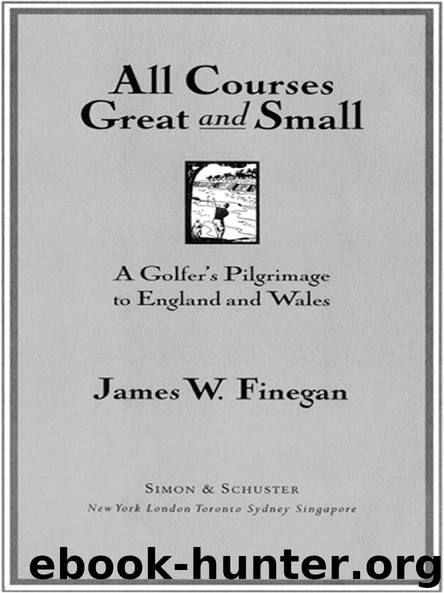All Courses Great and Small by James W. Finegan

Author:James W. Finegan
Language: eng
Format: epub
Publisher: SIMON & SCHUSTER
Published: 2003-07-15T00:00:00+00:00
The course today is largely attributable to Philip Mackenzie Ross, who was responsible for the resuscitation of Turnberry’s Ailsa Course after World War II. Alterations were made to the Ross layout here some twenty years later by Fred W. Hawtree.
L’Ancresse, as the course is generally referred to by Channel Islanders, is bounded by the beautiful bays of Grand Havre and L’Ancresse. It doubles as a pasture—by law, the Guernsey cattle have grazing rights. This is authentic links golf: duneland that sometimes tumbles violently, sometimes scarcely undulates at all, and boasts tall golden-fescue rough, plus more than its share of gorse. The course at its longest measures 6,215 yards; par is 70. There is a sharp contrast between the two nines, to the clear detriment of the outbound half, which is too often level and uninspired. Oh, there are a couple of very stiff two-shelters, 438 and 461 yards, and a couple of first-rate par threes, 181 and 190 yards, each very good in its own right but similar in length and design. Still, the first nine is a disappointment.
Fortunately, the second nine comes to the rescue. Here the holes range from good to great, thanks to land full of feature and dramatic elevation changes (the dizzying drop on the short par-four 13th, the exhausting climb to the green on the 306-yard 17th, which, into a stout breeze, can play 425 yards!). The 407-yard 15th is a great par four, our drive from an elevated tee piercing the prevailing wind to pass a huge, old stone tower on the right and land amidst heaving terrain on the lower ground, the long second shot now scaling a steep embankment to gain the green.
As for the 18th, I don’t know where we will ever play a hole quite like it. Talk about a top-of-the-world tee—well, walking onto it, the first thing we think of is not the shot but the panorama of this entire end of the island and, if the day is sunny, its surrounding cobalt seas. It is heart-stopping. Then comes this simple shot, just 156 yards but falling, falling, falling through a zephyr or a breeze or a wind or a gale to a green that would like to be hospitable, not too many paces from a spiffy new clubhouse where you can be assured of a warm welcome.
The cobbled streets and historic architecture of Guernsey’s capital, St. Peter Port, cry out to be explored, but we barely scratched the surface. Maybe you’ll agree that we had a good excuse. We stayed at La Fregate (The Frigate), an eighteenth-century manor house in St. Peter Port. The public spaces are not appealing. Our room, #10—large, comfortable, cheerful—was not attractively furnished. Still, we cannot imagine staying anywhere else on the island. Why? Because the setting and the view add up to enchantment. This thirteen-room hotel is tucked away on a garden hillside with surpassing views of the harbor (small pleasure craft, big ferry boats, a fishing fleet, and thirteenth-century Castle Cornet on guard at the seaward end).
Download
This site does not store any files on its server. We only index and link to content provided by other sites. Please contact the content providers to delete copyright contents if any and email us, we'll remove relevant links or contents immediately.
Golf is Not a Game of Perfect by Bob Rotella(1035)
Final Rounds by James Dodson(981)
Letters to a Young Writer by Colum McCann(975)
Caddyshack by Chris Nashawaty(877)
My Life in and out of the Rough by John Daly(867)
Back Spin by Harlan Coben(842)
Chasing Greatness by Adam Lazarus(825)
The Caddy's Cookbook by Tripp Bowden(825)
Alice Cooper: Golf Monster by Alice Cooper(817)
The First Major by John Feinstein(807)
The Sorceress by Michael Scott(803)
How Champions Think: In Sports and in Life by Bob Rotella(794)
No Limits: My Autobiography by Ian Poulter(781)
Every Shot Counts by Mark Broadie(778)
Carl Hiaasen by The Downhill Lie(769)
Scott, Michael - The Sorceress by Scott Michael(754)
Golf and Philosophy by Wible Andy(739)
The Flexible Golf Swing by Roger Fredericks(725)
Hank Haney's Essentials of the Swing by Hank Haney(712)
